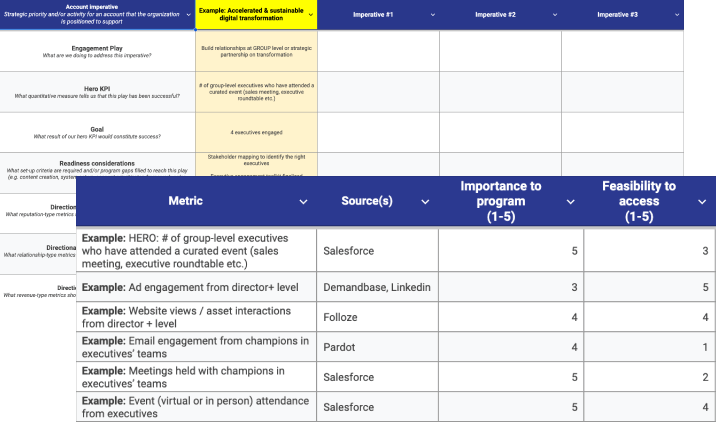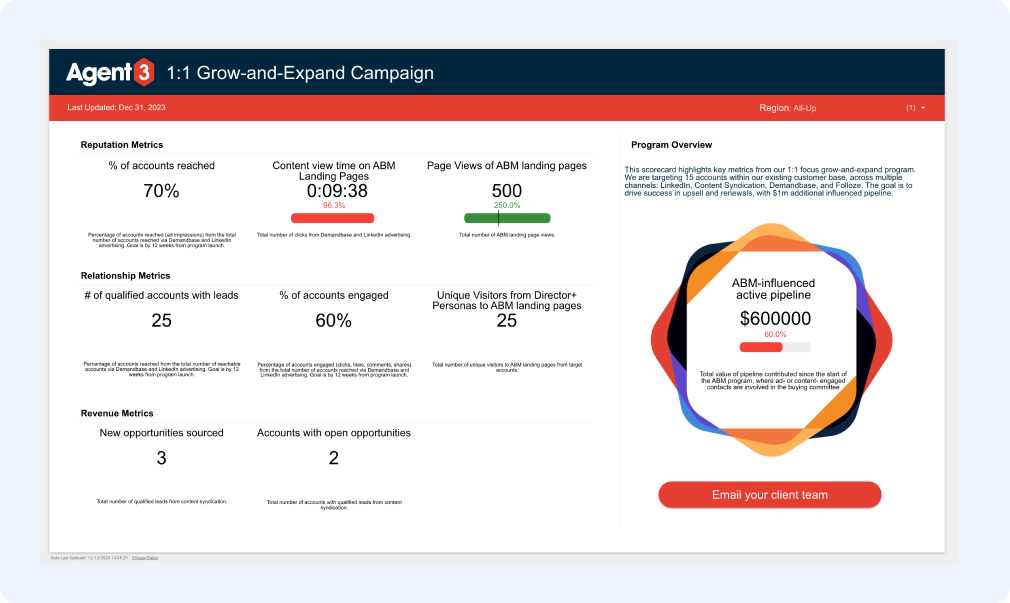1. The state of ABM measurement
Although demonstration of value is top of many of their priority lists, time and time again, marketing leaders and ABM practitioners tell us that measuring ABM is a thorn in their side. And it’s a feeling that’s prevalent across the industry. The 2024 Gartner Tech Marketing Benchmarks survey found that ABMers cited measuring attribution and evaluating ABM success as two of their top three challenges. This is despite martech receiving the largest split of marketing budgets at B2B companies. So where’s the disconnect? Why isn’t there a plug-and-play solution that tells you, dollar-in-for-dollar-out, whether it was all worth it?
The short answer is that successful ABM measurement, particularly of 1:1 or 1:few “Precision” ABM, is nuanced. No off-the-shelf solution will be able to understand the intricacies of your organizational landscape and stakeholders, not to mention the specifics of your 1:1 and 1:few program imperatives and objectives. And yet getting ABM measurement right relies on measuring the right things, at the right time, in ways that resonate with the right people.
So what to do? Scrutiny on marketing spending and activity continues to grow, as does the volume of tools and solutions to assist. To cut through the noise, we need to simplify. It all starts with one question – why do you want to do measurement in the first place?
2. The three roles of ABM measurement
When we talk about ABM measurement, typically we’re talking about three different things:
- Generating Insights
- Reporting on performance
- Analyzing program impact
In this guide, we’re primarily going to focus on the latter - determining our ABM success metrics. While all have a critical role to play in the successful delivery and execution of precision ABM, CMOs and organizational leadership typically want to focus on program impact and success. This is also where ABMers struggle most to form a complete and compelling narrative.
3. Reflecting business needs in ABM measurement
As an industry, we’ve fallen into a trap. We’ve been running marketing campaigns and measuring the same things on autopilot. All too often we measure what we can – the things that are easy and habitual - impressions, clicks, CTR, leads, MQLs, SQLs.
These tactical campaign performance metrics can help us make ad delivery adjustments. However, they are, at best, incomplete for showing ABM’s contribution to the business in a way that matters to stakeholders. Instead, we need to consider the critical questions that ABM measurement needs to answer for each stakeholder:
Measurement Key Questions
At Agent3 we use the following key questions to interrogate the brief and start to put together a plan for KPIs and metrics. This helps turn the nebulous question of success into a pragmatic one of what we did, what happened, what the result was, and – critically – why it matters.
Priority Measurement Questions
4. The 4Rs Framework and sample metrics
There is a sea of data on what you could measure to understand your Precision ABM impact and success. At Agent3, we help break this down using 4 x Rs (Revenue, Reputation, Relationships and Readiness). We also look at these based on the “maturity” of ABM at an organization – that is to say, how established and ingrained ABM is within the organizational culture, and whether programs are actively live in market vs in early stage pilots. We’ll discuss ABM maturity, why it matters, and its impact on KPI selection in more detail in a little bit.
The grid below is not exhaustive, nor is it a challenge to see how many of these things you can measure. Instead, we use this for inspiration for ABM success metrics and program progression measurement, choosing different metrics for different program imperatives.
The 4R Framework
With so many metrics available, often the easiest place to start is a pragmatic one. While you might have an overarching goal handed down to you by the organization, you may also need to generate this for yourself. In this case, we recommend the following steps:
- Start wide. Take your activity plan with all your account imperatives and engagement plays, and assign 1-2 “hero KPIs” per play that will tell you what success would look like for that play. Ideally, set a benchmark for these ABM success metrics – either based on industry standards or, better yet, historical data from your organization
- Get Deep. Underpin this with what you would need to get to these hero KPI from a readiness, reputation, relationship and potentially even revenue perspective.
Step back. Taking a fifty-foot view, what would the summation of our hero KPIs deliver? Are there commonalities that, if we achieved them, would speak to wider program success?
To support you in achieving this, we have a selection of template worksheets where you can jot down your imperatives, plays and KPIs to help build your measurement blueprint.
Download our Precision ABM Measurement and Scorecard Templates

5. The path to ABM ROI: program maturity and metrics throughout the ABM funnel
ABM maturity: typical measurement success questions at different stages of your program maturity
When we talk about telling the full story of ABM measurement, and showing the full “4Rs” worth of measurement opportunities, we often get pushback along the lines of “well it’s simple, my executives only care about ROI”. And that’s great – there’s no doubt that it always comes back to the $$$. The challenge is that that sort of result only starts showing in a mature ABM program – one that is live in the market, and only then even the earliest-stage indicators come after at least a full sales or renewal cycle has occurred. Given that an enterprise sales cycle can take six months or more, and a renewal cycle is often annual or every two years, this leaves an uncomfortable void between when programs commence and when the “only result that matters” finally appears.
Unfortunately, marketing’s legacy is of years spent trying to fill the timeline gap with unwieldy slide decks, full of so-called “vanity metrics” all intended to show “impact”. The result was often that dreaded “so what?”. Or worse, at the other end, we see wildly unrealistic calculations of ABM ROI that don’t stand up to questioning and erode trust in the value that the activity provides.
However, with the right approach, we can foster a common understanding of why only reporting on revenue is unrealistic, set appropriate expectations, and give stakeholders a clear path to understanding and witnessing progress towards a revenue result.To achieve this, it’s critical to track your readiness and early-stage reputation and relationship performance metrics to tell the complete story of your program’s success. Imagine you were running a lead generation program – your goal might be 100 leads, but whether that’s a success or a failure depends on how much you invested, whether those leads match your ideal customer profile and whether those leads were delivered on time with creative that was produced on-budget.
Considering your readiness metrics also help you to break down your target result into a more manageable plan, and illustrate the timeline to achieving it – targeting $1,000,000 of marketing-influenced revenue in isolation may sound daunting; but knowing you are going to get there by producing X pieces of content, distributed over Y channels, with Z budget to support it becomes immensely more manageable. On reflection, it also provides you with the granularity to understand how you met that target so you can optimize the process next time.
Then, in the early days of a live program, we can show that the planned assets have been launched on time and on budget, whereas in the weeks after launch (if not days), we need to show “quick win” reputation metrics such as opens, clicks and web visit data. Over time we progress towards metrics that are oriented around relationships like engagement with key buyers and revenue in generating early-stage opportunities. Finally, long-term metrics like pipeline, ABM-influenced revenue and increases in areas like average deal size and velocity-to-close can be shown later in the program. As ABM professionals, we must guide other teams into understanding what those initial, early and mid stage metrics mean – and how they can act as leading indicators for future results.
6. Enabling ABM Measurement: partnerships and process
When we plan Precision ABM programs, we put customer-centricity at the heart of everything. Measurement should follow the same ethos, even if the customer here is your stakeholder and wider organization.

Measurement breeds confidence!
Watch our video on measurement where we discuss how innovations in data and technology impacts the measurement of marketing performance and pipeline.
Customer-centricity and partnership with ABM measurement isn’t just about knowing your stakeholders and collaborating with them on KPI selection and timelines. It’s also a case of collaborating around getting the data in the first place.
Creating an industry-leading Precision ABM experience requires a wide range of technologies – and ownership of these can fall within a variety of departments. Many will be in sales and marketing, but there may be other solutions in place at functions within the business such as a centralized digital team or even customer success.
Forming a comprehensive picture of where you can source insights requires you to map out where these platforms are, and who owns them. Like so many aspects of an ABX program, sourcing insights and driving measurement has to be a collaborative cross-functional effort.
When you’ve found the right contact who has the information that you want, you need to establish a partnership. This will ensure you can reliably get the data you need, and have the expertise on hand to understand and interpret the information and translate it into insights for your target audience. It’s all about building trust and a collaborative relationship – saying “I'm here to support you and be a partner.” You don't want the data owner to feel like we're here to muscle in on their job and replace them - because we're not. However, we do need to rapidly build the right relationships to help get ABMers what they need to do their job seamlessly.
Tips for successfully approaching platform owners
- Does the data owner understand the purpose of ABM and are they bought in?
- Does the data owner have time to support the project?
- How does this ABX Measurement project stack up against competing priorities?
Questions to ask platform owners
- Does the right data exist to help measure the ABX KPI?
- Is the available data actionable?
- Does the owner have access to the data and are they willing to share?
7. Delivering an ABM dashboard
A Precision ABM measurement journey starts with a clearly articulated vision, which aligns with your business goals and ABM maturity, as well as the actual activity you plan to undertake. From here, we can gather and analyze KPIs, assess viability, and plan to create cohesion among the tech stack and teams involved in any ABM endeavor. This is the foundation of a blueprint for success, and is what underpins the creation of any ABM dashboard.
With all of this documented in a detailed project blueprint you will have the foundations you need to answer the right questions for the right stakeholders at the right time – and ultimately demonstrate the value of your ABM initiative throughout the customer life cycle. However, a story is only ever as good as the person who tells it. Now it’s up to you to present back your insights to your stakeholders in a visually engaging and compelling way.
Email measurement@agent3.com today to find out more about how we can help you measure what matters.






